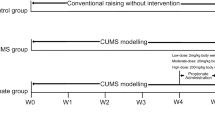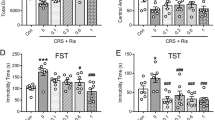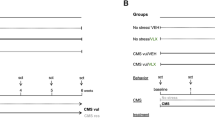Abstract
The neuropeptide substance P and its receptor, the neurokinin 1 receptor (NK1R) have been proposed as possible targets for new antidepressant therapies. The present study investigated the effect of the NK1R antagonist L-760,735 and the tricyclic antidepressant clomipramine in the chronic psychosocial stress paradigm of adult male tree shrews. Animals were subjected to a 7-day period of psychosocial stress before the onset of daily oral administration of L-760,735 (10 mg kg−1 day−1) or clomipramine (50 mg kg−1 day−1). The psychosocial stress continued throughout the treatment period of 28 days. Brain metabolite concentrations were determined in vivo by proton magnetic resonance spectroscopy. Cell proliferation in the dentate gyrus and hippocampal volume were measured post mortem. Stress significantly decreased in vivo concentrations of N-acetyl-aspartate (−14%), creatine and phosphocreatine (−15%) and choline-containing compounds (−15%). The proliferation rate of the granule precursor cells in the dentate gyrus was reduced (−45%), and hippocampal volume was decreased (−14%). The stress-induced changes of brain metabolites, hippocampal volume and dentate cytogenesis rate were prevented by concomitant drug administration. Elevated myo-inositol concentrations after both treatments hint to an astrocytic enhancement. These results suggest that—despite a different pharmacological profile—the NK1R antagonist L-760,735, a member of a novel class of antidepressant drugs, has comparable neurobiological efficacy to tricyclic antidepressants such as clomipramine.
This is a preview of subscription content, access via your institution
Access options
Subscribe to this journal
Receive 12 print issues and online access
$259.00 per year
only $21.58 per issue
Buy this article
- Purchase on Springer Link
- Instant access to full article PDF
Prices may be subject to local taxes which are calculated during checkout




Similar content being viewed by others
References
Saria A . The tachykinin NK1 receptor in the brain: pharmacology and putative functions Eur J Pharmacol 1999 375: 51–60
Ribeiro-da-Silva A, Hökfelt T . Neuroanatomical localisation of substance P in the CNS and sensory neurons Neuropeptides 2000 34: 256–271
Siegel RA, Düker EM, Fuchs E, Pahnke U, Wuttke W . Responsiveness of mesolimbic, mesocortical, septal, and hippocampal cholecystokinin and substance P neuronal systems to stress in the male rat Neurochem Int 1984 6: 783–789
Takamaya H, Ota Z, Ogawa N . Effect of immobilization stress on neuropeptides and their receptors in rat central nervous system Reg Peptides 1986 15: 239–248
Harbuz MS, Jessop DS . Stress and inflammatory disease: widening roles for serotonin and substance P Stress 2001 4: 57–70
Wong ML, Licinio J . Research and treatment approaches to depression Nat Rev Neurosci 2001 2: 343–351
Kramer MS, Cutler N, Feighner J, Shrivastava R, Carman J, Sramek JJ et al. Distinct mechanism for antidepressant activity by blockade of central substance P receptors Science 1998 281: 1640–1645
Rupniak NMJ . New insights into the antidepressant actions of substance P (NK1 receptor) antagonists Can J Physiol Pharmacol 2002 (in press)
Rupniak NMJ, Carlson EC, Harrison T, Oates B, Seward E, Owen S et al. Pharmacological blockade or genetic deletion of substance P (NK1) receptors attenuates neonatal vocalisation in guinea-pigs and mice Neuropharmacology 2000 39: 1413–1421
Boyce S, Smith D, Carlson E, Hewson L, Rigby M, O'Donnell R et al. Intra-amygdala injection of substance P (NK1 receptor) antagonist L-760735 inhibits neonatal vocalisations in guinea-pigs Neuropharmacology 2001 41: 130–137
Stout SC, Owens MJ, Nemeroff CB . Neurokinin1 receptor antagonists as potential antidepressants Ann Rev Pharmacol Toxicol 2001 41: 877–906
Argyropoulos SV, Nutt DJ . Substance P antagonists: novel agents in the treatment of depression Expert Opin Investig Drugs 2000 9: 1871–1875
Sergeyev V, Hökfelt T, Hurd Y . Serotonin and substance P co-exist in dorsal raphe neurons of the human brain NeuroReport 1999 10: 3967–3970
Santarelli L, Gobbi G, Debs PC, Sibille E, Blier P, Hen R et al. Genetic and pharmacological disruption of neurokinin 1 receptor function decreases anxiety-related behaviors and increases serotonergic function Proc Natl Acad Sci USA 2001 98: 1912–1917
Haddjeri N, Blier P . Sustained blockade of neurokinin-receptors enhances serotonin neurotransmission Biol Psychiatry 2001 50: 191–199
Froger N, Gardier AM, Moratalla R, Alberti I, Lena I, de Felipe C et al. 5-HT1A autoreceptor adaptive changes in substance P (NK1) receptor knock-out mice mimic antidepressant-induced desensitization J Neurosci 2001 21: 8188–8197
Leroy V, Mauser P, Gao Z, Peet N . Neurokin receptor antagonists Exp Opin Invest Drugs 2000 9: 735–746
Manji HK, Drevets WC, Charney DS . The cellular neurobiology of depression Nat Med 2001 7: 541–547
McEwen BS . Stress and hippocampal plasticity Annu Rev Neurosci 1999 22: 105–122
Duman RS, Heninger GR, Nestler EJ . A molecular and cellular theory of depression Arch Gen Psychiatry 1997 54: 597–606
Duman RS, Malberg J, Thome J . Neural plasticity to stress and antidepressant treatment Biol Psychiatry 1999 46: 1181–1191
Jacobs BL, Praag H, Gage FH . Adult brain neurogenesis and psychiatry: a novel theory of depression Mol Psychiatry 2000 5: 262–269
Malberg JE, Eisch AJ, Nestler EJ, Duman RS . Chronic antidepressant treatment increases neurogenesis in adult rat hippocampus J Neurosci 2000 20: 1904–1910
Manev H, Uz T, Smalheiser NR, Manev R . Antidepressants alter cell proliferation in the adult brain in vivo and in neural cultures in vitro Eur J Pharmacol 2001 411: 67–70
Czeh B, Michaelis T, Watanabe T, Frahm J, de Biurrun G, van Kampen M et al. Stress-induced changes in cerebral metabolites, hippocampal volume and cell proliferation are prevented by antidepressant treatment with tianeptine Proc Natl Acad Sci USA 2001 98: 12796–12801
McTavish D, Benfield P . Clomipramine: an overview of its pharmacological properities and a review of its therapeutic use in obsessive compulsive disorder and panic disorder Drugs 1990 39: 136–153
Kendler KS, Karkowski LM, Prescott CA . Causal relationship between stressful life events and the onset of major depression Am J Psychiatry 1999 156: 837–841
van Kampen M, Kramer M, Hiemke C, Flügge G, Fuchs E . The chronic psychosocial stress paradigm in male tree shrews: evaluation of a novel animal model for depressive disorders Stress 2001 5: 37–46
Fuchs E . Tree shrews. In: Poole T (ed) UFAW Handbook on the Care and Management of Laboratory Animals Blackwell: Oxford 1999 235–245
Tattersall FD, Rycroft W, Marmont N, Cascieri M, Hill RG, Hargreaves RJ . Enantiospecific inhibition of emesis induced by nicotine in the house musk shrew (Suncus murinus) by the neurokinin1 (NK1) receptor antagonist CP-99,994 Neuropharmacology 1995 34: 1697–1699
Fuchs E, Kramer M, Hermes B, Netter P, Hiemke C . Psychosocial stress in tree shrews: clomipramine counteracts behavioral and endocrine changes Pharmacol Biochem Behav 1996 54: 219–228
van Kampen M, Schmitt U, Hiemke C, Fuchs E . Diazepam has no beneficial effects on stress-induced behavioural and endocrine changes in male tree shrews Pharmacol Biochem Behav 2000 65: 539–546
Birken DL, Oldendorf WH . N-acetyl-L-aspartic acid: a literature review of a compound prominent in 1H-NMR spectroscopy studies of the brain Neurosci Biobehav Rev 1989 13: 23–31
Urenjak J, Williams SR, Gadian DG, Noble M . Proton nuclear magnetic resonance spectroscopy unambiguously identifies different neural cell types J Neurosci 1993 13: 981–989
Brand A, Richter-Landsberg C, Leibfritz D . Multinuclear NMR studies on the energy metabolism of glial and neuronal cells Dev Neurosci 1993 15: 289–298
Michaelis T, de Biurrun G, Watanabe T, Frahm J, Ohl F, Fuchs E . Gender-specific alterations of cerebral metabolites with aging and cortisol treatment J Psychiat Res 2001 35: 231–271
Provencher SW . Estimation of metabolite concentrations from localized in vivo proton NMR spectra Magn Reson Med 1993 30: 672–679
Michaelis T, Wick M, Fujimori H, Matsumura A, Frahm J . Proton MRS of oral creatine supplementation in rats. Cerebral metabolite concentrations and ischemic challenge NMR Biomed 1999 12: 309–314
Takahashi T, Nowakowski RS, Caviness VS . BrdU as an S-phase marker for quantitative studies of cytokinetic behaviour in the murine cerebral ventricular zone J Neurocytol 1992 21: 185–197
Gould E, McEwen BS, Tanapat P, Galea LA, Fuchs E . Neurogenesis in the dentate gyrus of the adult tree shrew is regulated by psychosocial stress and NMDA receptor activation J Neurosci 1997 17: 2492–2498
Fuchs E, Jöhren O, Flügge G . Psychosocial conflict in the tree shrew: effects of sympathoadrenal activity and blood pressure Psychoneuroendocrinology 1993 18: 557–565
Manji HK, Moore GJ, Chen G . Clinical and preclinical evidence for the neurotrophic effects of mood stabilizers: implications for the pathophysiology and treatment of manic-depressive illness Biol Psychiatry 2000 48: 740–754
Renshaw PF, Lafer B, Babb SM, Fava M, Stoll AL, Christensen JD et al. Basal ganglia choline levels in depression and response to fluoxetine treatment: an in vivo proton magnetic resonance spectroscopy study Biol Psychiatry 1997 41: 837–843
Frey R, Metzler D, Fischer P, Heiden A, Scharfetter J, Moser E et al. Myo-inositol in depressive and healthy subjects determined by frontal 1H-magnetic resonance spectroscopy at 1.5 tesla J Psychiat Res 1998 32: 411–420
Winsberg ME, Sachs N, Tate DL, Adalsteinsson E, Spielman D, Ketter TA . Decreased dorsolateral prefrontal N-acetyl-aspartate in bipolar disorders Biol Psychiatry 2000 47: 475–481
Steingard RJ, Yurgelun-Todd DA, Hennen J, Moore JC, Moore CM, Vakili K et al. Increased orbitofrontal cortex levels of choline in depressed adolescents as detected by in vivo proton magnetic resonance spectroscopy Biol Psychiatry 2000 48: 1053–1061
Auer DP, Pütz B, Kraft E, Lipinski B, Schill J, Holsboer F . Reduced glutamate in the anterior cingulate cortex in depression: an in vivo proton magnetic resonance spectroscopy study Biol Psychiatry 2000 47: 305–313
Moore GJ, Bebchuk JM, Hasanat K, Chen G, Seraji-Bozorgzad N, Wilds IB et al. Lithium increases N-acetyl-aspartate in the human brain: in vivo evidence in support of bcl-2’s neurotrophic effects? Biol Psychiatry 2000 48: 1–8
Rajkowska G . Postmortem studies in mood disorders indicate altered numbers of neurons and glial cells Biol Psychiatry 2000 48: 766–777
Gross CG . Neurogenesis in the adult brain: death of a dogma Nature Neurosci Rev 2000 1: 67–73
Chen G, Rajkowska G, Du F, Seraji-Bozorgzad N, Manji HK . Enhancement of hippocampal neurogenesis by lithium J Neurochem 2000 75: 1729–1734
Millan MJ, Lejeune F, de Nanteuil G, Gobert AJ . Selective blockade of neurokinin (NK1) receptor facilitates the activity of adrenergic pathways projecting to frontal cortex and dorsal hippocampus J Neurochem 2001 76: 1949–1954
Tao R, Ma Z, Auerbach SB . Differential effects of local infusion of serotonin reuptake inhibitors in the raphe nucleus versus forebrain and the role of depolarization-induced release in increased serotonin J Pharamacol Exp Therap 2000 294: 571–579
Gurvits TV, Shenton ME, Hokama H, Ohta H, Lasko NB, Orr SP et al. Reduced hippocampal volume on magnetic resonance imaging in chronic post-traumatic stress disorder Biol Psychiatry 1996 40: 1091–1099
Sheline Y, Wang P, Gado M, Csernansky J, Vannier M . Hippocampal atrophy in major depression Proc Natl Acad Sci USA 1996 93: 3908–3913
Bremner JD, Narayan M, Anderson ER, Staib LH, Miller HL, Charney DS . Hippocampal volume reduction in major depression Am J Psychiatry 2000 157: 115–117 2
Sapolsky RM . Glucocorticoids and hippocampal atrophy in neuropsychiatric disorders Arch Gen Psychiatry 2000 57: 925–935
Magarinos AM, McEwen BS, Flügge G, Fuchs E . Chronic psychosocial stress causes apical dendritic atrophy of hippocampal CA3 pyramidal neurons in subordinate tree shrews J Neurosci 1996 15: 3534–3540
McEwen BS . Effects of adverse experiences for brain structure and function Biol Psychiatry 2000 48: 721–731
Sousa N, Lukoyanov NV, Madeira MD, Almeida OFX, Paula-Barbosa MM . Reorganization of the morphology of hippocampal neurites and synapses after stress-induced damage correlates with behavioral improvement Neuroscience 2000 97: 253–266
Acknowledgements
This work was in part supported by Merck, Sharp and Dohme Research Laboratories and by a grant of the BMBF (0311467B).
Author information
Authors and Affiliations
Corresponding author
Rights and permissions
About this article
Cite this article
van der Hart, M., Czéh, B., de Biurrun, G. et al. Substance P receptor antagonist and clomipramine prevent stress-induced alterations in cerebral metabolites, cytogenesis in the dentate gyrus and hippocampal volume. Mol Psychiatry 7, 933–941 (2002). https://doi.org/10.1038/sj.mp.4001130
Received:
Revised:
Accepted:
Published:
Issue Date:
DOI: https://doi.org/10.1038/sj.mp.4001130
Keywords
This article is cited by
-
Neuropeptides Substance P and Calcitonin Gene Related Peptide Accelerate the Development and Fibrogenesis of Endometriosis
Scientific Reports (2019)
-
The Neurobiology of Depression: an Integrated Overview from Biological Theories to Clinical Evidence
Molecular Neurobiology (2017)
-
The hippocampus in major depression: evidence for the convergence of the bench and bedside in psychiatric research?
Molecular Psychiatry (2011)
-
Requirement of AQP4 for Antidepressive Efficiency of Fluoxetine: Implication in Adult Hippocampal Neurogenesis
Neuropsychopharmacology (2009)
-
Chronic therapy with citalopram decreases regional cerebral glucose utilization in OBX, and not sham-operated, rats: an autoradiographic study
Psychopharmacology (2009)



